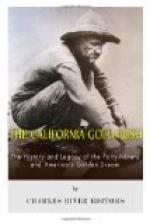This was in the latter days of 1848. In the first part of 1849 the immigrants began to arrive. They had to have places to sleep, things to eat, transportation to the diggings, outfits of various sorts. In the first six months of 1849 ten thousand people piled down upon the little city built to accommodate eight hundred. And the last six months of the year were still more extraordinary, as some thirty thousand more dumped themselves on the chaos of the first immigration. The result can be imagined. The city was mainly of canvas either in the form of tents or of crude canvas and wooden houses. The few substantial buildings stood like rocks in a tossing sea. No attempt, of course, had been made as yet toward public improvements. The streets were ankle-deep in dust or neck-deep in mud. A great smoke of dust hung perpetually over the city, raised by the trade winds of the afternoon. Hundreds of ships lay at anchor in the harbor. They had been deserted by their crews, and, before they could be re-manned, the faster clipper ships, built to control the fluctuating western trade, had displaced them, so that the majority were fated never again to put to sea.
Newcomers landed at first on a flat beach of deep black sand, where they generally left their personal effects for lack of means of transportation. They climbed to a ragged thoroughfare of open sheds and ramshackle buildings, most of them in the course of construction. Beneath crude shelters of all sorts and in great quantities were goods brought in hastily by eager speculators on the high prices. The four hundred deserted ships lying at anchor in the harbor had dumped down on the new community the most ridiculous assortment of necessities and luxuries, such as calico, silk, rich furniture, mirrors, knock-down houses, cases and cases of tobacco, clothing, statuary, mining-implements, provisions, and the like.
The hotels and lodging houses immediately became very numerous. Though they were in reality only overcrowded bunk-houses, the most enormous prices were charged for beds in them. People lay ten or twenty in a single room—in row after row of cots, in bunks, or on the floor. Between the discomfort of hard beds, fleas, and overcrowding, the entire populace spent most of its time on the street or in the saloons and gambling, houses. As some one has pointed out, this custom added greatly to the apparent population of the place. Gambling was the gaudiest, the best-paying, and the most patronized industry. It occupied the largest structures, and it probably imported and installed the first luxuries. Of these resorts the El Dorado became the most famous. It occupied at first a large tent but soon found itself forced to move to better quarters. The rents paid for buildings were enormous. Three thousand dollars a month in advance was charged for a single small store made of rough boards. A two-story frame building on Kearny Street near the Plaza paid its owners a hundred and twenty thousand dollars a




